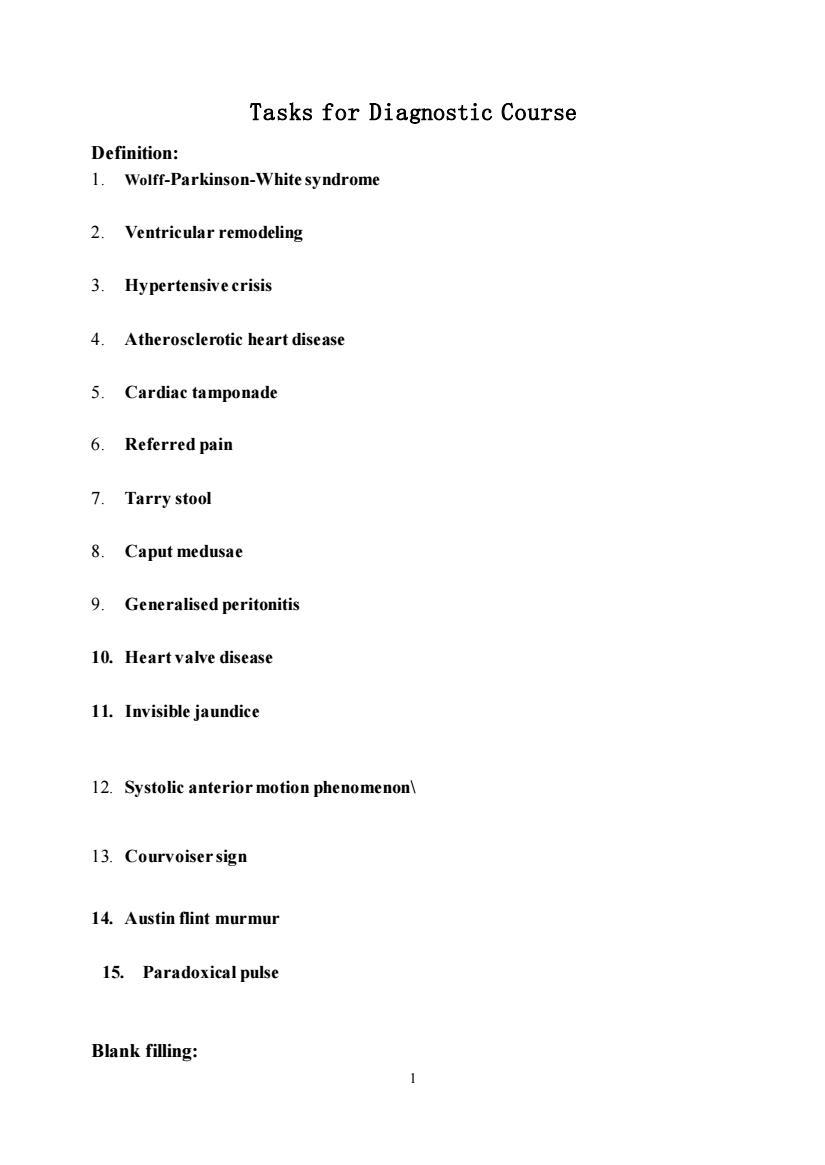
Tasks for Diagnostic Course Definition: 1.Wolff-Parkinson-White syndrome 2.Ventricular remodeling 3.Hypertensive crisis 4.Atherosclerotic heart disease 5.Cardiac tamponade 6.Referred pain 7.Tarry stool 8.Caput medusae 9.Generalised peritonitis 10.Heart valve disease 11.Invisible jaundice 12.Systolic anterior motion phenomenon 14.Austin flint murmur 15.Paradoxical pulse Blank filling:
1 Tasks for Diagnostic Course Definition: 1. Wolff-Parkinson-White syndrome 2. Ventricular remodeling 3. Hypertensive crisis 4. Atherosclerotic heart disease 5. Cardiac tamponade 6. Referred pain 7. Tarry stool 8. Caput medusae 9. Generalised peritonitis 10. Heart valve disease 11. Invisible jaundice 12. Systolic anterior motion phenomenon\ 13. Courvoiser sign 14. Austin flint murmur 15. Paradoxical pulse Blank filling:
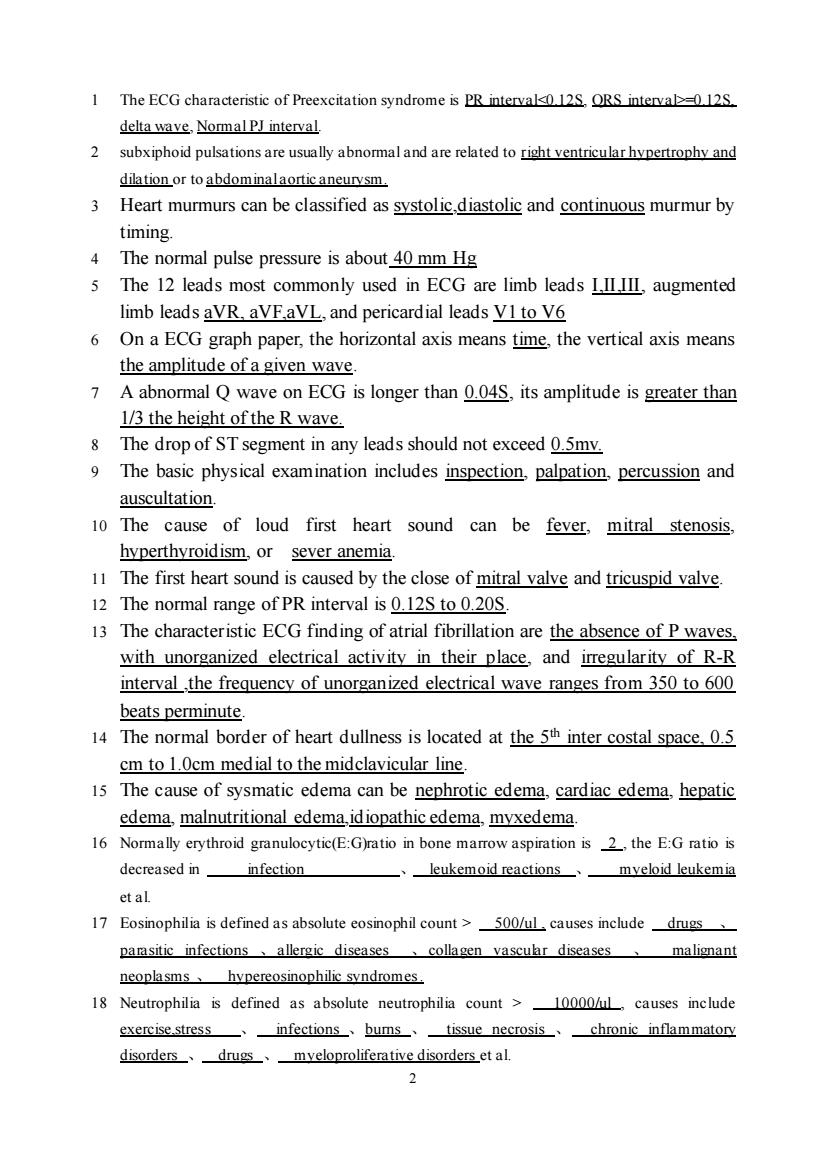
1 The ECG characteristic of Preexcitation syndrome is PRintera12 ORS intera12 delta wave.Normal PI interval subxiphoid pulsations are usually abnommal and are related to right ventricularhypertrophy and dilation or to abdominalaortic aneurysm 3 Heart murmurs can be classified as systolic,diastolic and continuous murmur by timing. 4 The normal pulse pressure is about 40 mm Hg 5 The 12 leads most commonly used in ECG are limb leads LIIIIL,augmented limb leads aVR aVE aVL,and pericardial leads V1 to V6 6 On a ECG graph paper,the horizontal axis means time,the vertical axis means the amplitude of a given wave 7 A abnormal Q wave on ECG is longer than 0.04S,its amplitude is greater than 1/3 the height of the R wave. 8 The drop of ST segment in any leads should not exceed 0.5mv. 9 The basic physical examination includes inspection,palpation,percussion and auscultation. 10 The cause of loud first heart sound can be fever,mitral stenosis hyperthyroidism,or sever anemia. 11 The first heart sound is caused by the close of mitral valve and tricuspid valve. 12 The normal range of PR interval is 0.12S to 0.20S. 13 The characteristic ECG finding of atrial fibrillation are the absence of P waves. with unorganized electrical activity in their place,and irregularity of R-R interval the frequency of unorganized electrical wave ranges from 350 to 600 beats perminute. 14 The normal border of heart dullness is located at the 5th inter costal space.0.5 cm to 1.0cm medial to the midclavicular line. 15 The cause of sysmatic edema can be nephrotic edema,cardiac edema,hepatic edema,malnutritional edema idiopathic edema,myxedema. 16 Normally erythroid granulocytic(E:G)ratio in bone marrow aspiration is2.the E:G ratiois decreased in infection 、leukemoid reactions mveloid leukemia et al 17 Eosinophilia is defined as absolute eosinophil count>500/ulcauses include drugs parasitic infections,allergic diseases collagen vasculr diseases malignant neoplasms,hypereosinophilic syndromes. 18 Neutrophilia is defined as absolute neutrophilia count>include exercise.stress 、_infections、bums、_tissue necrosis chronic inflammatory disorders drugs mveloproliferative disorders et al. 2
2 1 The ECG characteristic of Preexcitation syndrome is PR interval<0.12S, QRS interval>=0.12S, delta wave, Normal PJ interval. 2 subxiphoid pulsations are usually abnormal and are related to right ventricular hypertrophy and dilation or to abdominal aortic aneurysm. 3 Heart murmurs can be classified as systolic,diastolic and continuous murmur by timing. 4 The normal pulse pressure is about 40 mm Hg 5 The 12 leads most commonly used in ECG are limb leads I,II,III, augmented limb leads aVR, aVF,aVL, and pericardial leads V1 to V6 6 On a ECG graph paper, the horizontal axis means time, the vertical axis means the amplitude of a given wave. 7 A abnormal Q wave on ECG is longer than 0.04S, its amplitude is greater than 1/3 the height of the R wave. 8 The drop of ST segment in any leads should not exceed 0.5mv. 9 The basic physical examination includes inspection, palpation, percussion and auscultation. 10 The cause of loud first heart sound can be fever, mitral stenosis, hyperthyroidism, or sever anemia. 11 The first heart sound is caused by the close of mitral valve and tricuspid valve. 12 The normal range of PR interval is 0.12S to 0.20S. 13 The characteristic ECG finding of atrial fibrillation are the absence of P waves, with unorganized electrical activity in their place, and irregularity of R-R interval ,the frequency of unorganized electrical wave ranges from 350 to 600 beats perminute. 14 The normal border of heart dullness is located at the 5th inter costal space, 0.5 cm to 1.0cm medial to the midclavicular line. 15 The cause of sysmatic edema can be nephrotic edema, cardiac edema, hepatic edema, malnutritional edema,idiopathic edema, myxedema. 16 Normally erythroid granulocytic(E:G)ratio in bone marrow aspiration is 2 , the E:G ratio is decreased in infection 、 leukemoid reactions 、 myeloid leukemia et al. 17 Eosinophilia is defined as absolute eosinophil count > 500/ul , causes include drugs 、 parasitic infections 、allergic diseases 、collagen vascular diseases 、 malignant neoplasms 、 hypereosinophilic syndromes . 18 Neutrophilia is defined as absolute neutrophilia count > 10000/ul , causes include exercise,stress 、 infections 、burns 、 tissue necrosis 、 chronic inflammatory disorders 、 drugs 、 myeloproliferative disorders et al
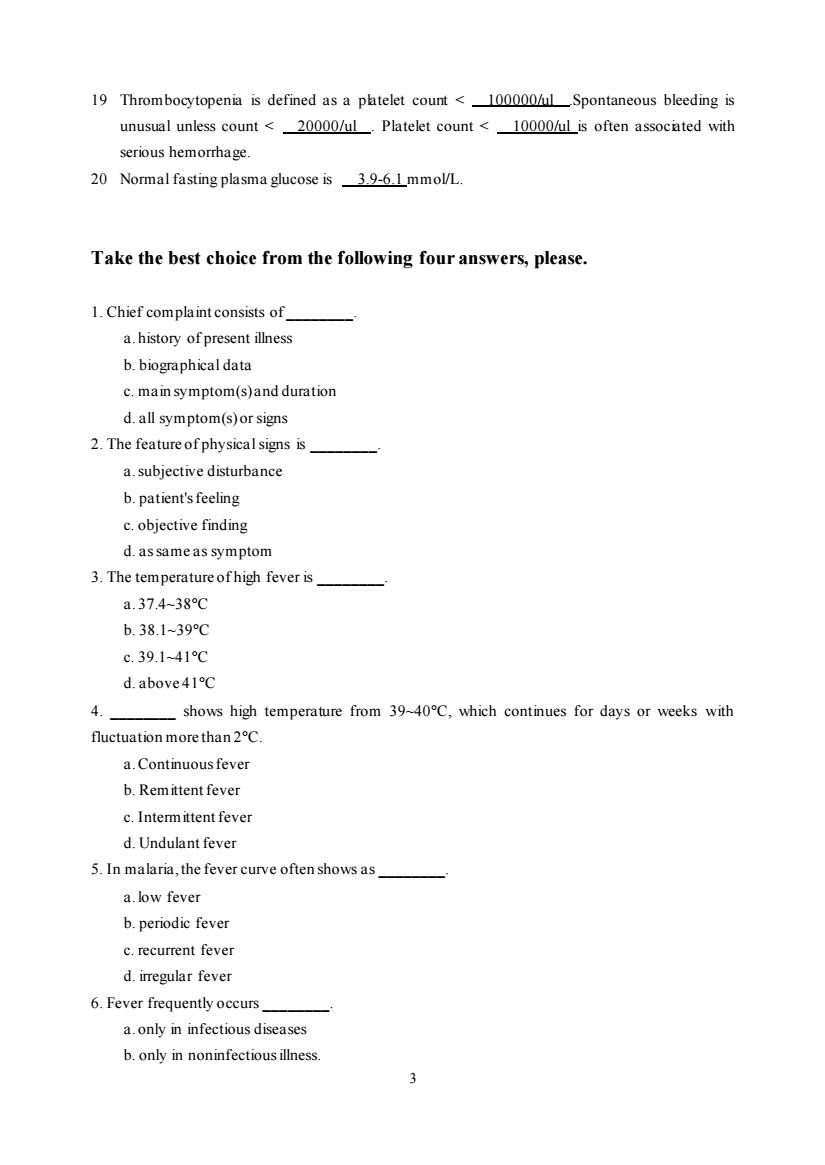
19 Thrombocytopenia is defined as a platelet count<100000/uLSpontaneous bleeding is unusual unless count<20000/uL Platelet count<10000/uLis often assocated with serious hemorrhage. 20 Normal fasting plasma glucose is39-6.1mmol/L. Take the best choice from the following four answers,please. .Chief complaint consists of a.history ofpresent illness b.biographical data c.main symptom(s)and duration d.all symptom(s)or signs 2.The featureofphysicalsigns is a.subjective disturbance b.patient's feeling c.objective finding d.assameas symptom 3.The temperatureofhigh fever is a.37.4-38℃ b.38.1-39C c.39.1-41℃ d.above41C 4. shows high temperature from 39-40C.which continues for days or weeks with fluctuation more than2C a.Continuous fever b.Remittent fever c.Intermittent feve d.Undulant fever 5.In malaria,the fever curve often shows as a.low fever b.periodic fever c.recurrent fever d.irregular fever 6.Fever frequently occurs a.only in infectious diseases b.only in noninfectious illness
3 19 Thrombocytopenia is defined as a platelet count < 100000/ul .Spontaneous bleeding is unusual unless count < 20000/ul . Platelet count < 10000/ul is often associated with serious hemorrhage. 20 Normal fasting plasma glucose is 3.9-6.1 mmol/L. Take the best choice from the following four answers, please. 1. Chief complaint consists of _. a. history of present illness b. biographical data c. main symptom(s) and duration d. all symptom(s) or signs 2. The feature of physical signs is _. a. subjective disturbance b. patient's feeling c. objective finding d. as same as symptom 3. The temperature of high fever is _. a. 37.4~38°C b. 38.1~39°C c. 39.1~41°C d. above 41°C 4. _ shows high temperature from 39~40°C, which continues for days or weeks with fluctuation more than 2°C. a. Continuous fever b. Remittent fever c. Intermittent fever d. Undulant fever 5. In malaria, the fever curve often shows as _. a. low fever b. periodic fever c. recurrent fever d. irregular fever 6. Fever frequently occurs _. a. only in infectious diseases b. only in noninfectious illness
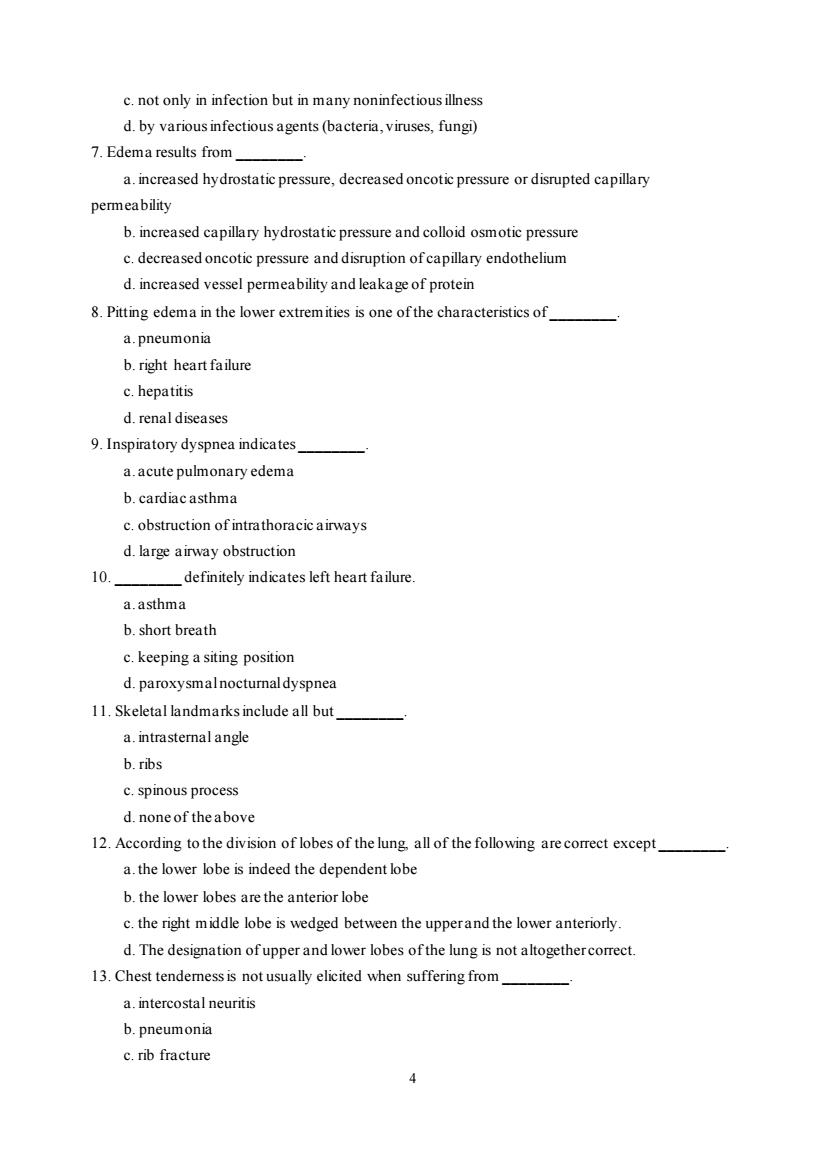
c.not only in infection but in many noninfectiousess d.by various infectious agents(bacteria,viruses,fungi) 7.Edema results from a.increased hydrostatic pressure,decreased oncoticpressure or disrupted capillary permeability b.increased capillary hydrostatic pressure and colloid osmotic pressure c.decreasedoncotic pressure and disruption of capillary endothelium d.increased vessel permeability and leakage of protein 8.Pitting edema in the lower extremities is one ofthe characteristics of a.pneumonia b.right heart failure c.hepatitis d.renaldiseases 9.Inspiratory dyspnea indicates a.acute pulmonary edema c.obstruction of intrathoracicairways d.large airway obstruction 10. definitely indicates left heart failure a asthma b.short breath c.keeping a siting position d.paroxysmalnoctumal dyspnea 11.Skeletal landmarks include all but a.intrastemalangle b.ribs c.spinous process d.none of theabove 12.According tothe division of lobes of the lung all of the following are correct except a.the lower lobe is indeed the dependent lobe b.the lower lobes are the anterior lobe c.the right middle lobe is wedged between the upperand the lower anteriorly d.The designation ofupper and lower lobes ofthe lung is not altogethercorrect 13.Chest tendemess is not usually elicited when suffering from_ b.pneumonia c.rib fracture 4
4 c. not only in infection but in many noninfectious illness d. by various infectious agents (bacteria, viruses, fungi) 7. Edema results from _. a. increased hydrostatic pressure, decreased oncotic pressure or disrupted capillary permeability b. increased capillary hydrostatic pressure and colloid osmotic pressure c. decreased oncotic pressure and disruption of capillary endothelium d. increased vessel permeability and leakage of protein 8. Pitting edema in the lower extremities is one of the characteristics of _. a. pneumonia b. right heart failure c. hepatitis d. renal diseases 9. Inspiratory dyspnea indicates _. a. acute pulmonary edema b. cardiac asthma c. obstruction of intrathoracic airways d. large airway obstruction 10. _ definitely indicates left heart failure. a. asthma b. short breath c. keeping a siting position d. paroxysmal nocturnal dyspnea 11. Skeletal landmarks include all but _. a. intrasternal angle b. ribs c. spinous process d. none of the above 12. According to the division of lobes of the lung, all of the following are correct except _. a. the lower lobe is indeed the dependent lobe b. the lower lobes are the anterior lobe c. the right middle lobe is wedged between the upper and the lower anteriorly. d. The designation of upper and lower lobes of the lung is not altogether correct. 13. Chest tenderness is not usually elicited when suffering from _. a. intercostal neuritis b. pneumonia c. rib fracture
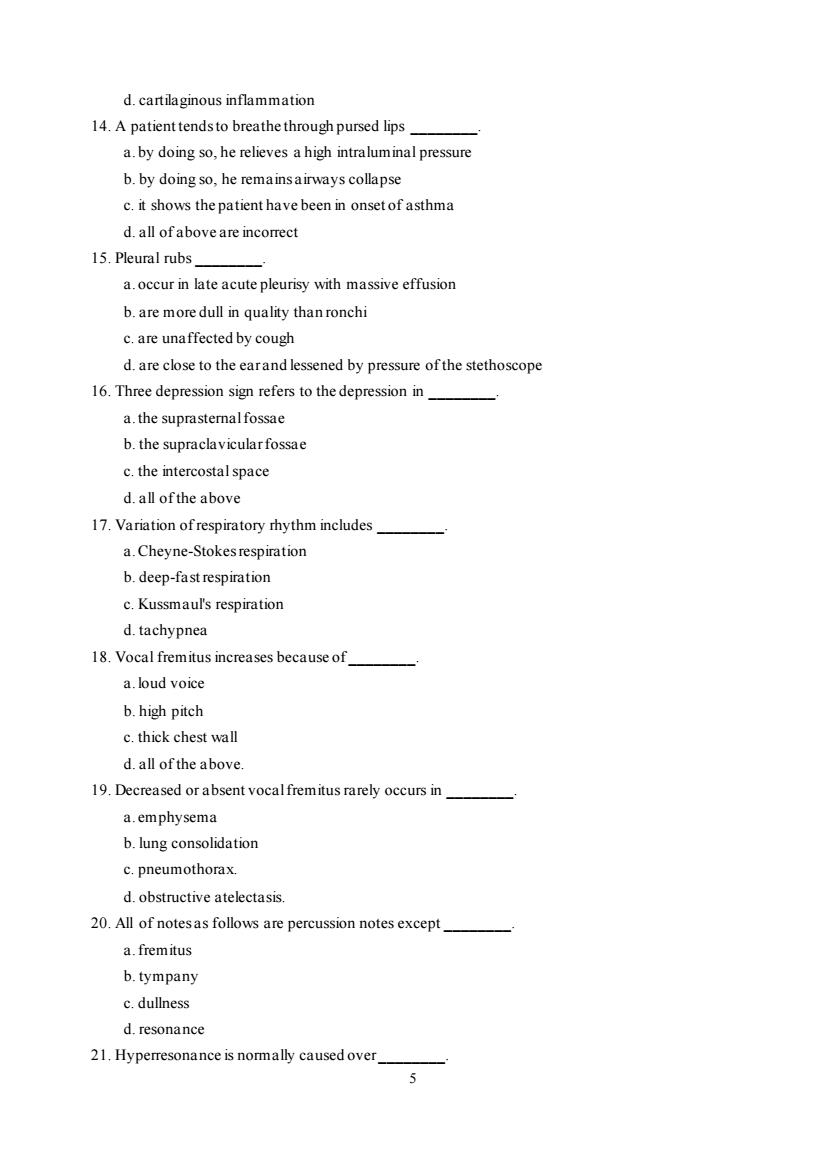
d.cartilaginous inflammation 14.A patient tendsto breathe through pursed lips a.by doing so,he relieves a high intraluminal pressure b.by doing so,he remainsairways collapse c.it shows the patient have been in onsetof asthma d.all ofaboveare incorrect 15.Pleural rubs a.occur in late acute pleurisy with massive effusion b.are more dull in quality thanronchi c.are unaffected by cough d.are close to the earand lessened by pressure ofthe stethoscope 16.Three depression sign refers to the depression in a.the suprasternalfossae b.the supraclavicular fossae c.the intercostal space d.all ofthe above 17.Variation ofrespiratory rhythm includes a.Cheyne-Stokesrespiration b.deep-fast respiration c.Kussmauls respiration d.tachypnea 18.Vocal fremitus increases because of a.loud voice b.high pitch c.thick chest wall d.all of the above 19.Decreased orabsent vocalfremitus rarely occurs in a.emphysema b.lung consolidation c.pneumothorax. d.obstructive atelectasis 20.All of notesas follows are percussion notes except a.fremitus b.tympany c.dullness d.resonance 21.Hyperresonance is nommally caused over 5
5 d. cartilaginous inflammation 14. A patient tends to breathe through pursed lips _. a. by doing so, he relieves a high intraluminal pressure b. by doing so, he remains airways collapse c. it shows the patient have been in onset of asthma d. all of above are incorrect 15. Pleural rubs _. a. occur in late acute pleurisy with massive effusion b. are more dull in quality than ronchi c. are unaffected by cough d. are close to the ear and lessened by pressure of the stethoscope 16. Three depression sign refers to the depression in _. a. the suprasternal fossae b. the supraclavicular fossae c. the intercostal space d. all of the above 17. Variation of respiratory rhythm includes _. a. Cheyne-Stokes respiration b. deep-fast respiration c. Kussmaul's respiration d. tachypnea 18. Vocal fremitus increases because of _. a. loud voice b. high pitch c. thick chest wall d. all of the above. 19. Decreased or absent vocal fremitus rarely occurs in _. a. emphysema b. lung consolidation c. pneumothorax. d. obstructive atelectasis. 20. All of notes as follows are percussion notes except _. a. fremitus b. tympany c. dullness d. resonance 21. Hyperresonance is normally caused over _